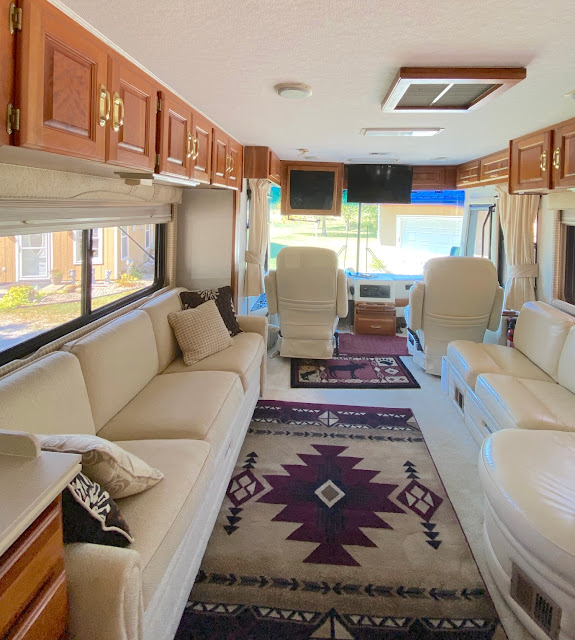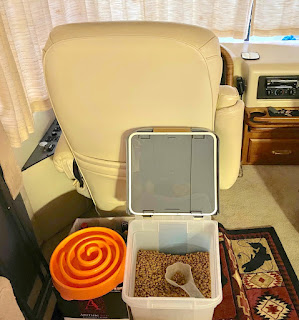Travel Days: Tear Down and Set Up
Travel days can be stressful.
There's a lot to remember before leaving the campground. We've heard horror stories of people ripping the electric hook-up out of the ground because they forgot to unplug 😳
Once on the road, the driver must monitor traffic, weather, and road conditions. And if you're the passenger, you must tend to anxious dogs who don't enjoy the bumpy ride 😆
For these reasons and more, the 2-2-2 rule is good to follow:
- Travel no more than 200 miles a day
- Travel no more than 2 hours without a break
- Stay a minimum of 2 days at each campsite
Divide and Conquer
As with most of our household chores, Geoff takes care of outside duties on travel days while I focus on the inside.
I don't know ALL that Geoff does to prepare us for travel (perhaps I can convince him to write an article someday...) but I do know he has a rather extensive checklist.
- Disconnect all hook-ups (electric - water - sewer)
- Roll up the awnings and tightly secure them
- Bring the slide in
- Ensure stabilizers/leveling jacks are up
- Dump the gray and black water tanks
I have a similar checklist for the inside.
The front of the cab is prime storage space when the coach is parked. When we are driving, however, we need to clear the space.We often keep coats in the driver's seat for easy access in-and-out the front door. I will hang these in the linen closet.
Behind that seat is a treasure trove of goodies. The dogs' food, feeding bowls, and feeding stands store neatly in this area, and make for easy access in the morning when Hero is "starving"
Our wine rack (aka cardboard wine case) is stored next to the dogs' food. And my 4 ft folding craft table is leaning against the wall.
On travel days, the dog food container and case of wine are stored under the dinette table. The craft table lays on one of the dinette benches. And the dog bowls and stands fit in one of the cabinets under the bench seating.
I then take out the trash and put the empty garbage cans in the shower. Sounds strange, I know. But the shower is a great place to store items and keep them from slip-sliding around the coach on travel days.
Next I make sure all flat surfaces are clear of any small items. Toothbrushes, handsoap, and any other bathroom products are stored in the medicine chest (we are fortunate to have this oversize cabinet).
The collapsible dish drainer is stored under the kitchen sink. The tea kettle is placed in one of the larger cabinets in the living room (same cabinet as the Instant Pot). The soap dish and sponges travel well inside the dishpan inside the sink. While I don't have a lot of decorative items (yet) the sink makes a great holding container.
I roll all the area rugs and put them in the center of the bed (the slide doesn't close with the rugs in place). I also put the Swiffer, broom, and cordless vacuum on the bed as well. Typically they are hanging on the bedroom wall when we are stationary. This keeps them from knocking against the wall when traveling.
When I'm at home I like to keep the top of bed free from clutter... but on the road, this is valuable real estate for moving day. "They" say RV traveling is akin to a level 4 earthquake 😳 so we must consider the movement of loose items in the coach as well as anything that bangs around. If I had wall art, I would also take that down and put in the center of the bed.
Since we typically travel for 4-5 hours a day, I try to think of an easy, convenient lunch to eat at a rest stop. Typically, this is a sandwich or leftovers I can warm in the microwave. I make sure all ingredients are easily accessible before we leave.
I also make sure the dogs have fresh water (we have a no-spill water bowl that really works). I try to remember to do this BEFORE Geoff disconnects the water outside. But we always carry spare water bottles, just in case.
It is at this time that I give Hero his calming chews. This is a new experiment, so we don't have concrete data. But we are hoping this helps his anxiety when Geoff leaves the coach at fuel stops.
Now I call upon my inner flight attendant skills. Starting from the back of the coach (the bedroom), I systematically check every drawer and door to make sure it is securely locked in place. The shower door is locked. The linen closet is locked. And the refrigerator door is secured with a tea towel. This ensures a relatively quiet trip down the road.At this point, Geoff is typically done outdoors and he starts to raise the stabilizers.Once I've identified the travel route, Geoff can easily access that information from his phone. And now we are ready to shove off.
Interesting to note... there is no formal check-out process at campgrounds.
Check-out time is typically later than an Airbnb or hotel (12:00 - 2:00pm) and when you are ready to leave you simply ...leave.
I like this leisurely morning pace. We can have our coffee and mentally prepare before tackling the pack-up process.
Setting Up Camp
When we arrive at the next campsite, the system works in reverse.Geoff checks us in at the office (and Hero is slowly learning that he will return). A welcome packet is provided that always provides a map of the grounds, identifies our particular site, and gives helpful information like the wifi password and any upcoming events.
Most sites are back-in, which terrifies me but Geoff handles with ease. First, we must disconnect the car and the dolly, and then Geoff backs into the space -- often succeeding the first time! (As a side note, a pull-through site does not require the removal of the car dolly).
Once we are lined up with the hook-ups, Geoff turns off the motor and goes to work. He takes care of utilities (electric - water - sewer) while I take care of Hero's anxiety. Once we have power, Geoff lets out the slide and I can now prepare the coach for daily living.
- Items from under and around the dinette are put back behind the driver's seat.
- All small items from the sinks are put back in place.
- Garbage cans are taken out of the shower and put in place.
- Items from the bed (area rugs and mops) are rehomed.
- The dogs' leashes are secured around the tires and left by the front door. The leashes are about nine feet long and allow the dogs to roam freely around the rig.
At this point, it is time for the dogs to eat and the grownups to celebrate with a glass of wine.






Comments
Post a Comment